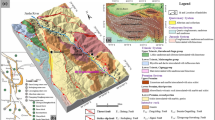Abstract
The upper reaches of the Minjiang River are located at the junction of the Qinghai-Tibet Plateau and Sichuan Basin, exhibiting a complex geological environment with high mountains and deep valleys. Many ancient dammed lake sedimentary strata are exposed along the valley in this area. The Tuanjie village landslide developed in the sediments of the Diexi ancient dammed lake. In this paper, the basic characteristics of this landslide and the physical and mechanical properties of the rock and soil of this landslide are determined by combining field drilling with laboratory testing. According to the geological environment characteristics and slope deformation characteristics of landslides, the movement mechanism of landslides is simulated by the numerical simulation software PFC2D, and the genetic mechanism of landslides that developed in large thick lacustrine sediments is discussed. The results show that (1) the sliding body, slip soil and slip bed of the Tuanjie village landslide are composed of lacustrine sedimentary soil; (2) the Tuanjie village landslide has undergone multiple reactivations at the front edge. The formation and revival of landslide are closely related to the water level change of Xiaohaizi reservoir, highway construction and operation, heavy rainfall and so on. (3) Additionally, the Tuanjie village landslide has the characteristics of backward traction failure.



















Similar content being viewed by others
Change history
30 July 2022
A Correction to this paper has been published: https://doi.org/10.1007/s10064-022-02847-0
References
Chen L (2017) Study on engineering geological characteristics of sediments in Diexi ancient barrier lake of Minjiang River. Chengdu University of Technology
Chen S, Chen J, Liu C et al (2016) Granularity characteristics of deposits from the break of the dammed lake caused by Xuelongnang ancient landslide in the upper Jinsha River. Chin J Soil Water Conserv 14(1):28–35. https://doi.org/10.16843/j.sswc.2016.01.004 (In Chinese)
Dai Z, Zhang C, Wang L, Fu Y, Zhang Y (2021) Interpreting the influence of rainfall and reservoir water level on a large-scale expansive soil landslide in the Danjiangkou Reservoir region, China. Eng Geol 288:106110. https://doi.org/10.1016/J.ENGGEO.2021.106110
Deng M, Yi Q, Lu S, Han B (2020) Deformation law and mechanism of chair soil landslide in the Three Gorges Reservoir Area – Taking Bazimen Landslide in Zigui as an example. South North Water Transf Water Conserv Sci Technol 18(2):135–143. https://doi.org/10.13476/j.cnki.nsbdqk.2020.0036
Ghazvinian A, Sarfarazi V, Schubert W, Blumel M (2012) A study of the failure mechanism of planar non-persistent OpenJoints using PFC2D. Rock Mech Rock Eng 45(5):677–693. https://doi.org/10.1007/s00603-012-0233-2
Hu G, Liu M, Chen N, Zhang X, Wu K, Khanal BR, Han D (2019) Real-time evacuation and failure mechanism of a giant soil landslide on 19 July 2018 in Yanyuan County, Sichuan Province, China. Landslides 16(6):1177–1187. https://doi.org/10.1007/s10346-019-01175-x
Jiang H, Mao X, Xu H, Yang H, Ma X, Zhong N, Li Y (2014) Provenance and earthquake signature of the last deglacial Xinmocun lacustrine sediments at Diexi, East Tibet. Geomorphology 204:518–531. https://doi.org/10.1016/J.ECOLIND.2021.107887
Lee H, Jeon S (2010) An experimental and numerical study of fracture coalescence in pre-cracked specimens under uniaxial compression. Int J Solids Struct 48(6):979–999. https://doi.org/10.1016/j.ijsolstr.2010.12.001
Luo BB (2020) Study on the extinction process and impact of Diexi ancient barrier lake. Chengdu University of Technology. https://doi.org/10.26986/d.cnki.gcdlc.2020.000059
Ministry of Transport of the People’s Republic of China (2015) General code for design of highway bridges and culverts (JTG d60–2015)
Wang XQ (2009) Research on environmental geological information of sediments in Diexi ancient dammed lake in upper Minjiang River. Chengdu University of Technology, Chengdu, China (Ph.D Dissertation, In Chinese)
Wang LS, Yang LZ, Wang XQ et al (2005) Discovery of huge ancient dammed lake on upstream of Minjiang River in Sichuan, China. J Chengdu Univ Technol 32(1):1–11 (In Chinese)
Wang P, Zhang B, Qiu W, Wang J (2011) Soft-sediment deformation structures from the Diexi paleo-dammed lakes in the upper reaches of the Minjiang River, east Tibet. J Asian Earth Sci 40(4):865–872. https://doi.org/10.1016/j.jseaes.2010.04.006
Wang W, Chen W, Long W, Die J (2018) Research and analysis on the landslide characteristics of Xigeda soil slope. Proceedings of 2nd International Workshop on Advances in Energy Science and Environment Engineering (AESEE 2018) (Advances in Energy Science and Environment Engineering II). International Conference on Humanities and Social Science Research, AEIC Academic Exchange Information Centre, China, p 5
Xu H, Chen J, Cui ZJ, Guo P (2018) Grain size characteristics of sediments in a dammed lake: a case study of the Diexi Ancient Dammed Lake upstream of the Minjiang River. Acta Sedimentol 5:1–12 (In Chinese)
Xu Q, Li W, Dong X, Xiao X, Fan X, Pei X (2017) Preliminary study on characteristics and genetic mechanism of landslide in Xinmo village, Diexi Town, Maoxian County, Sichuan. J Rock Mech Eng 36(11):2612–2628. https://doi.org/10.13722/j.cnki.jrme.2017.0855
Xu X, Wang L (2005) Zoning characteristics and genetic mechanism of slope deformation and failure in Diexi earthquake area in the upper reaches of Minjiang River [j]. J Eng Geol 1:68–75
Acknowledgements
The research reported in this manuscript is funded by the Natural Science Foundation of China (No. 41977226).
Author information
Authors and Affiliations
Corresponding author
Additional information
The original online version of this article was revised: Originally, Acknowledgements was missing for this article.
Rights and permissions
Springer Nature or its licensor holds exclusive rights to this article under a publishing agreement with the author(s) or other rightsholder(s); author self-archiving of the accepted manuscript version of this article is solely governed by the terms of such publishing agreement and applicable law.
About this article
Cite this article
Wang, X., Xiao, L., Zhao, J. et al. Analysis of the formation mechanism of a landslide in the lacustrine sediment of the Diexi ancient dammed lake in the upper reaches of the Minjiang River. Bull Eng Geol Environ 81, 328 (2022). https://doi.org/10.1007/s10064-022-02829-2
Received:
Accepted:
Published:
DOI: https://doi.org/10.1007/s10064-022-02829-2




